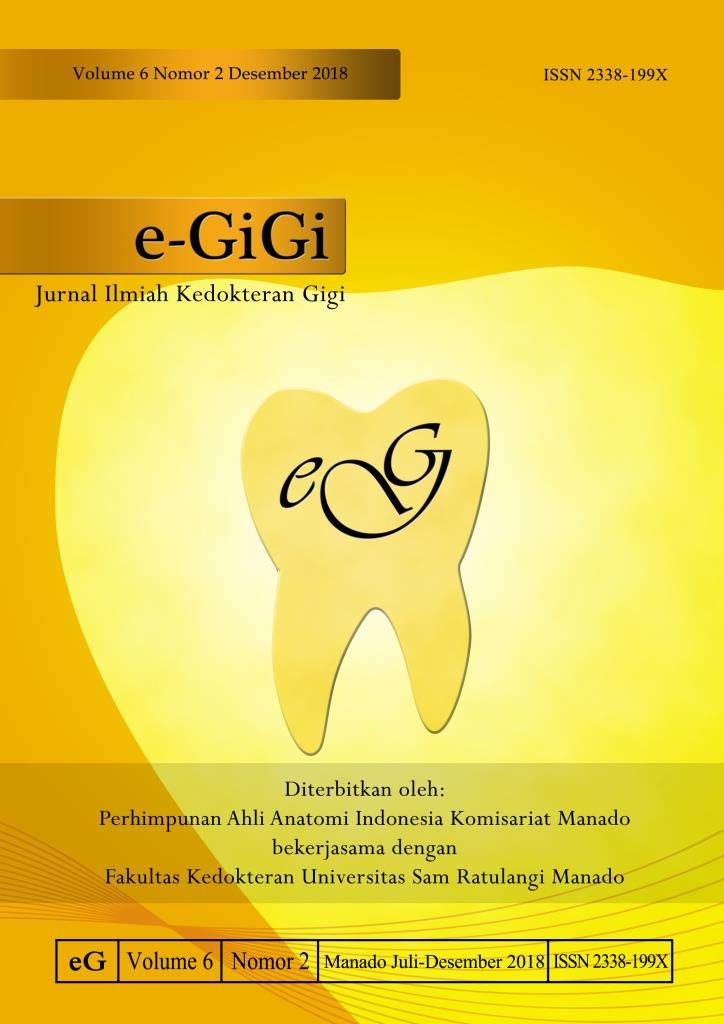Uji Konsentrasi Hambat Minimum Ekstrak Daun Gedi (Abelmoschus manihot L. Medik) terhadap Pertumbuhan Streptococcus mutans
DOI:
https://doi.org/10.35790/eg.6.2.2018.20200Abstract
Abstract: The main problem in dental health is dental caries that occurs due to the fermentation by Streptococcus mutans bacteria. Gedi leaf (Abelmoschus manihot L. Medical) is one of the common plants in Northern Celebes that contains antimicrobial compounds namely flavonoid, alkaloid, steroid, and saponin; all of them have been proved to inhibit the growth of S. mutans. This study was aimed to determine the minimal inhibitory concentration (MIC) of gedi leaf extract (Abelmoschus manihot L. Medical) to S. mutans growth. This was a true experimental study with a randomized pretest-posttest control group design. The method used in this study was serial dilution method with turbidimetry and spectrophotometry. Samples of gedi leaves were obtained at Paal 2 Manado, and were extracted with maceration method using ethanol 96%. S. mutans bacteria were obtained from the pure bacterial stock at Microbiology Laboratory of Pharmacy Study Program, Faculty of Mathematics and Natural Science University of Sam Ratulangi Manado. The turbidimetry test showed that the tube content became clearer at 25% of extract concentration. Moreover, the UV-Vis spectro-photometer showed a decrease of ï„OD value for the first time at 25% of extract concentration. Conclusion: The minimal inhibitory concentration (MIC) of gedi leaf extract (Abelmoschus manihot L. Medical) to Streptococcus mutans growth was at concentration of 25%.
Keywords: gedi leaf (Abelmoschus manihot L. Medical), Streptococcus mutans, MIC, dental caries
Â
Abstrak: Masalah utama dalam kesehatan gigi ialah karies gigi yang terbentuk karena proses peragian oleh bakteri Streptococcus mutans. Daun gedi (Abelmoschus manihot L. Medik) merupakan salah satu tanaman khas daerah Sulawesi Utara yang mengandung senyawa antimikroba berupa flavonoid, alkaloid, steroid, dan saponin yang telah terbukti memiliki efek antibakteri terhadap pertumbuhan S. mutans. Penelitian ini bertujuan untuk mengetahui konsentrasi hambat minimum (KHM) ekstrak daun gedi (Abelmoschus manihot L. Medik) terhadap pertumbuhan S. mutans. Jenis penelitian ialah eksperimental murni dengan pretest-posttest control group design. Metode yang digunakan dalam penelitian ini yaitu metode serial dilusi dengan pengujian turbidimetri dan spektrofotometri. Daun gedi diperoleh dari Kecamatan Paal 2 Manado, dan diekstraksi dengan metode maserasi menggunakan pelarut etanol 96%. Bakteri S. mutans diambil dari stok bakteri murni Laboratorium Mikrobiologi Program Studi Farmasi Fakultas MIPA Universitas Sam Ratulangi Manado. Hasil pengujian turbidimetri memperlihatkan bahwa larutan dalam tabung terlihat mulai jernih pada konsentrasi ekstrak 25%. Pada pengujian spektrofotometer UV-Vis terlihat penurunan nilai ï„OD pertama kali pada konsentrasi 25%. Simpulan: Konsentrasi hambat minimum ekstrak daun gedi (Abelmoschus manihot L. Medik) terhadap pertumbuhan Streptococcus mutans terdapat pada konsentrasi 25%.
Kata kunci: daun gedi (Abelmoschus manihot L. Medik), Streptococcus mutans, KHM, karies
Downloads
How to Cite
Issue
Section
License
COPYRIGHT
Authors who publish with this journal agree to the following terms:
Authors hold their copyright and grant this journal the privilege of first publication, with the work simultaneously licensed under a Creative Commons Attribution License that permits others to impart the work with an acknowledgment of the work's origin and initial publication by this journal.
Authors can enter into separate or additional contractual arrangements for the non-exclusive distribution of the journal's published version of the work (for example, post it to an institutional repository or publish it in a book), with an acknowledgment of its underlying publication in this journal.
Authors are permitted and encouraged to post their work online (for example, in institutional repositories or on their website) as it can lead to productive exchanges, as well as earlier and greater citation of the published work (See The Effect of Open Access).






